7 Common Pests Eating My Butterfly Bush
Butterfly bushes (Buddleja spp.) may be targeted by several pests, including aphids, spider mites, caterpillars, leaf miners, and scale insects. Aphids and whiteflies suck sap, leading to chlorosis and reduced photosynthesis, while caterpillars and Japanese beetles chew leaves, producing irregular holes and skeletonized foliage.
Spider mites leave stippling damage and webbing, whereas leaf miners create serpentine patterns in leaves, impacting photosynthesis. Scale insects form protective coatings on stems, depleting essential nutrients.
Effective pest management requires thorough monitoring and integrated control strategies. To understand the specific symptoms and advanced management techniques, further insights will be beneficial.
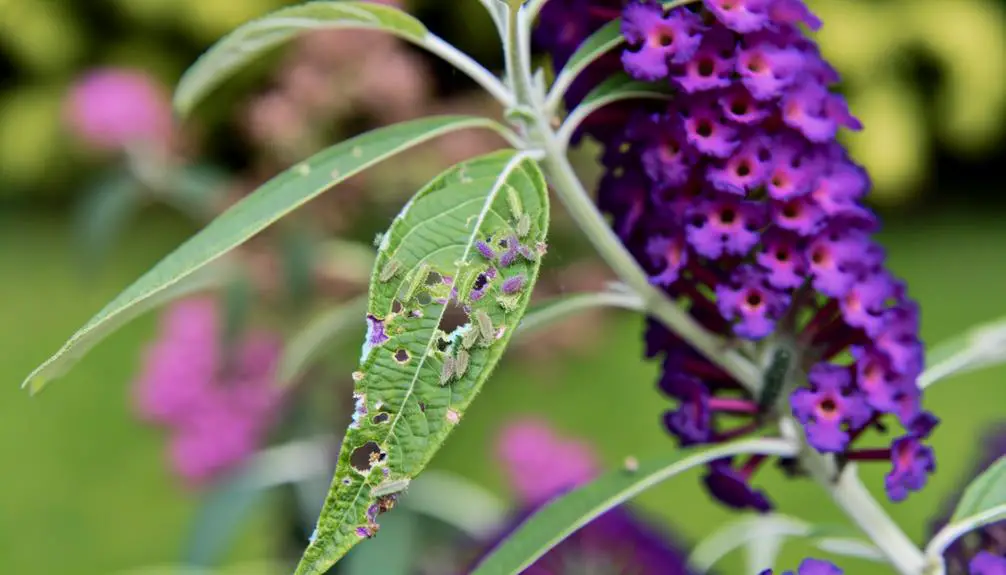
Key Takeaways
- Aphids, whiteflies, and scale insects are common sap-sucking pests causing chlorosis and stunted growth in butterfly bushes.
- Caterpillars and Japanese beetles cause significant foliar damage, leaving irregular holes and a skeletonized appearance on leaves.
- Thrips and spider mites feed on leaf cellular contents, leading to silvery, scarred leaves and webbing on foliage.
- Slugs and snails create irregular holes and mucous trails on foliage, typically active at night.
Aphids
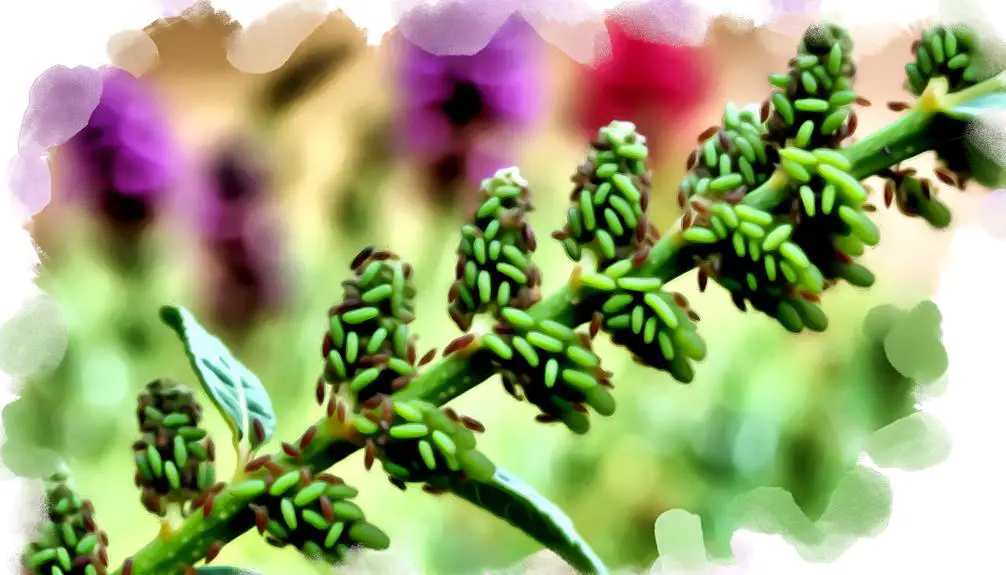
Aphids, small sap-sucking insects belonging to the superfamily Aphidoidea, are common pests that can severely damage butterfly bushes by feeding on their nutrient-rich sap. These diminutive arthropods utilize their specialized mouthparts, known as stylets, to penetrate plant phloem and extract essential nutrients.
This feeding mechanism often results in chlorosis, stunted growth, and distorted leaves, thereby compromising the aesthetic and physiological integrity of the butterfly bush. Aphids excrete honeydew, a sugary byproduct that fosters sooty mold growth on foliage, further hampering photosynthesis.
Additionally, these pests can act as vectors for various plant viruses, exacerbating the decline in plant health. Early detection and targeted management strategies are vital to mitigate the detrimental effects of aphid infestations on butterfly bushes.
Spider Mites
Spider mites, particularly Tetranychus urticae, can be identified by their characteristic webbing and the stippling damage they inflict on the foliage of Buddleja species.
Effective management includes the application of miticides and the introduction of natural predators, such as Phytoseiulus persimilis, to control their population.
Ensuring ideal plant health through proper watering and avoiding excessive nitrogen fertilization further aids in mitigating spider mite infestations.
Identifying Spider Mite Infestation
How can you discern a spider mite infestation on your butterfly bush? Recognizing the signs of these minuscule arachnids is essential for maintaining the health of your plant. Spider mites typically form colonies on the undersides of leaves, leading to distinct symptoms.
- Stippling Effect: Tiny, pale speckles appear on leaves due to chlorophyll extraction.
- Webbing: Fine, silk-like webbing may cover leaves and stems, a telltale sign of spider mite activity.
- Leaf Discoloration: Leaves may turn yellow, bronze, or exhibit a mottled appearance, indicating severe damage.
Understanding these indicators will enable you to take timely action to protect your butterfly bush.
Controlling Spider Mites Safely
Recognizing the symptoms of a spider mite infestation is the first step, but implementing effective and safe control measures is essential to protect your butterfly bush from further damage.
Regularly rinsing the foliage with a strong jet of water can dislodge spider mites, reducing their population.
Introducing natural predators such as Phytoseiulus persimilis, a predatory mite, can biologically control the pest.
Insecticidal soaps and horticultural oils like neem oil are also effective; they suffocate the mites without harming the plant.
It's critical to apply these treatments in the early morning or late evening to prevent phytotoxicity.
Consistent monitoring and integrated pest management (IPM) strategies are key to maintaining the health of your butterfly bush.
Caterpillars
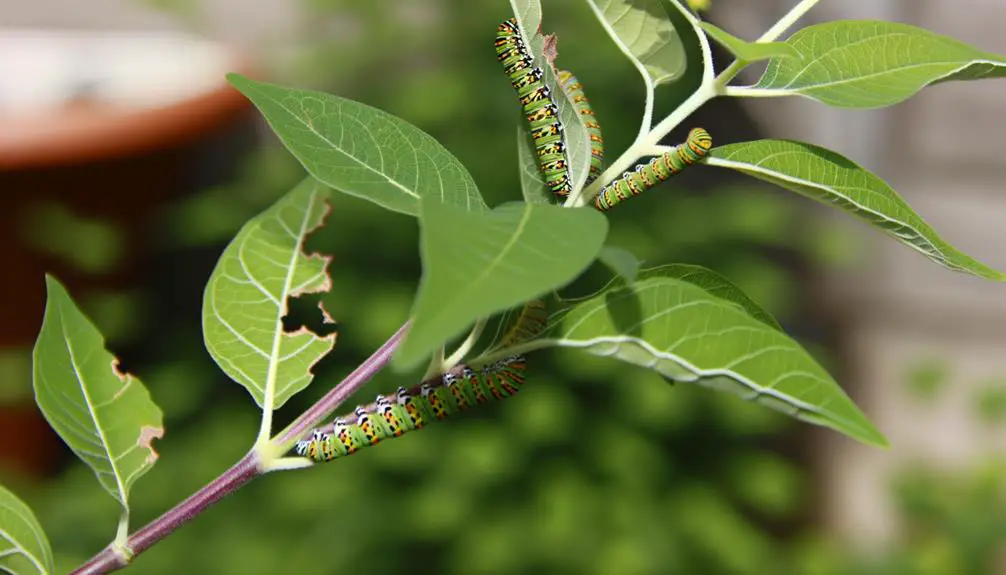
Caterpillars, the larval stage of butterflies and moths, are frequently responsible for significant foliar damage to butterfly bushes (Buddleja spp.), often leaving behind distinctive feeding patterns. These herbivorous insects exhibit voracious appetites, consuming large portions of leaves and sometimes entire plants if infestations are severe.
The damage typically manifests as irregular holes and notches along leaf edges, indicative of caterpillar feeding behavior.
The presence of caterpillars on butterfly bushes can evoke a range of emotions:
- Frustration over the destruction of prized garden plants.
- Concern for the overall health and vigor of the butterfly bush.
- Determination to identify and manage the culprits effectively.
Understanding these pests is essential for effective management and the preservation of plant health.
Leaf Miners
Leaf miners, small larvae that burrow into leaves, cause distinctive serpentine or blotchy patterns on butterfly bush foliage.
Understanding their lifecycle, from egg deposition to larval feeding stages, is essential for effective management.
Implementing preventive measures, such as regular monitoring and applying systemic insecticides, can greatly reduce leaf miner infestations.
Identifying Leaf Miner Damage
Identifying leaf miner damage on your butterfly bush involves examining the foliage for serpentine trails or blotchy patterns, which are indicative of larval feeding activity within the leaf tissue.
These minuscule larvae create distinctive, winding paths as they consume the mesophyll layer, causing significant aesthetic and physiological stress to the plant. Early detection is essential for effective management and to prevent further deterioration.
- Heartbreaking defoliation: The once lush, green leaves can become riddled with unsightly trails.
- Vibrant leaves dulled: The damage often leads to chlorosis, diminishing the plant's overall vibrancy.
- Compromised photosynthesis: Extensive mining disrupts chlorophyll function, impairing the plant's ability to photosynthesize.
Understanding these signs will help you take timely action.
Lifecycle of Leaf Miners
Understanding the lifecycle of leaf miners is essential for effective management and involves recognizing the stages from egg deposition to larval development, pupation, and eventual emergence of the adult insect. Female leaf miners deposit eggs on the underside of leaves. Upon hatching, larvae burrow into the leaf tissue, creating characteristic tunnels. The larval stage is followed by pupation, either within the leaf or in the soil. Finally, adult insects emerge, ready to reproduce and perpetuate the cycle.
| Lifecycle Stage | Duration (Days) | Key Characteristics |
|---|---|---|
| Egg | 3-5 | Deposited on leaf underside |
| Larval | 7-14 | Tunneling within leaf tissue |
| Pupation | 10-15 | Occurs in leaf or soil |
| Adult Emergence | 1-3 | Adults ready for reproduction |
Precise understanding aids in timely and targeted interventions.
Preventing Leaf Miner Infestation
Implementing an integrated pest management strategy is essential for preventing leaf miner infestation on butterfly bushes. This approach combines cultural, biological, and chemical methods to maintain plant health. One effective cultural practice is to encourage biodiversity by planting native plants instead of butterfly bush, which can help support natural predators of leaf miners. Additionally, introducing beneficial insects such as parasitic wasps can provide biological control by reducing leaf miner populations. If infestations persist, selective insecticides may be used as a last resort while minimizing harm to beneficial insects.
Regular monitoring is vital to detect early signs of leaf miner activity. Introducing natural predators, such as parasitic wasps, can effectively reduce leaf miner populations.
Implementing proper irrigation and nutrient management practices enhances plant resilience against infestations. In cases where infestations are severe, targeted use of insecticides may be necessary, but judicious application is paramount to minimize environmental impact.
- Early detection: Frequent inspections to spot initial symptoms.
- Natural predators: Encourage beneficial insects to control pests.
- Optimal care: Maintain robust plant health through proper watering and fertilization.
Scale Insects
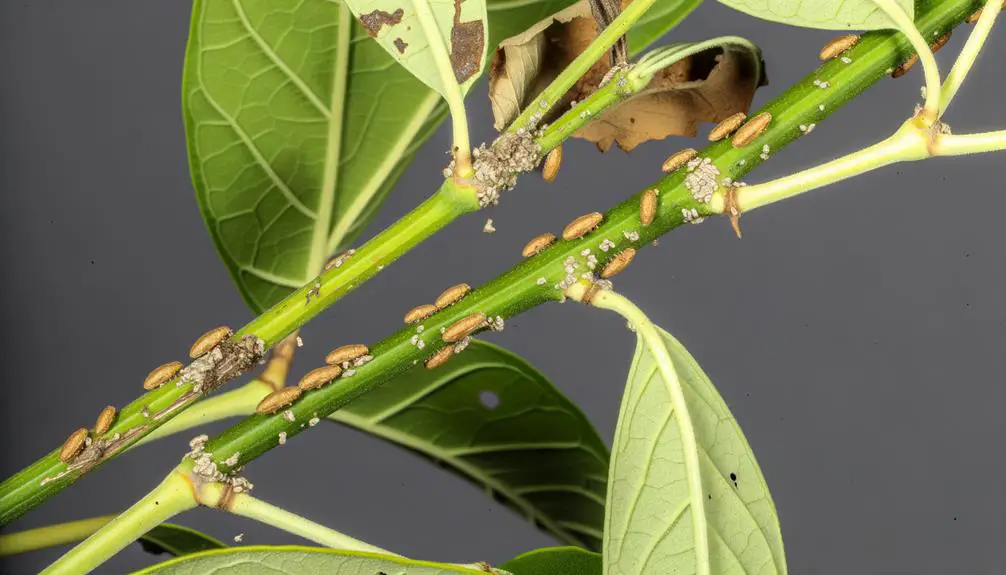
Scale insects, small sap-feeding pests, often form protective waxy coatings on butterfly bush stems and leaves, leading to diminished plant vigor and potential dieback. These pests belong to the superfamily Coccoidea and exhibit a sedentary life stage, during which they anchor themselves to plant tissues.
Their feeding activity depletes essential nutrients, resulting in chlorosis, stunted growth, and leaf drop. Additionally, scale insects excrete honeydew, a sugary substance that fosters sooty mold growth, further impairing photosynthesis.
Effective management involves regular inspection, physical removal of infested plant parts, and the application of horticultural oils or systemic insecticides. Integrated Pest Management (IPM) strategies, including promoting natural predators like ladybugs and parasitic wasps, can also mitigate scale insect populations.
Whiteflies
Whiteflies, small sap-sucking insects, often infest butterfly bushes, leading to chlorosis and reduced plant vigor.
Identifying a whitefly infestation involves observing the undersides of leaves for tiny white insects and sticky honeydew deposits.
Effective control strategies include introducing natural predators such as lady beetles and applying horticultural oils to disrupt their reproductive cycle.
Identifying Whitefly Infestation
Frequently, a whitefly infestation on a butterfly bush can be identified by the presence of tiny, white, moth-like insects congregating on the undersides of the leaves. These pests are notorious for their rapid reproduction and ability to cause significant damage to plants.
Symptoms to look for include:
- Yellowing leaves: Chlorosis resulting from sap extraction.
- Sticky residue: Honeydew excreted by whiteflies, leading to sooty mold growth.
- Stunted growth: Reduced vigor due to nutrient depletion.
Early detection is essential, as whiteflies can quickly overwhelm a butterfly bush, leading to its decline. Proper identification allows for timely intervention, ensuring the health and importance of the plant.
Controlling Whitefly Spread
Effectively managing whitefly spread on butterfly bushes necessitates a combination of cultural, biological, and chemical control strategies.
Culturally, guarantee proper plant spacing to enhance air circulation and reduce whitefly habitat. Regularly inspect and remove infested leaves to curtail population growth.
Biologically, introduce natural predators like Encarsia formosa, a parasitic wasp, which targets whitefly larvae. Additionally, deploying yellow sticky traps can monitor and reduce adult whitefly populations.
Chemically, employ insecticidal soaps or neem oil, which are less harmful to beneficial insects. Systemic insecticides such as imidacloprid may be used for severe infestations but should be applied cautiously to prevent resistance development.
Integrated Pest Management (IPM) principles should guide all efforts to guarantee sustainable control.
Japanese Beetles
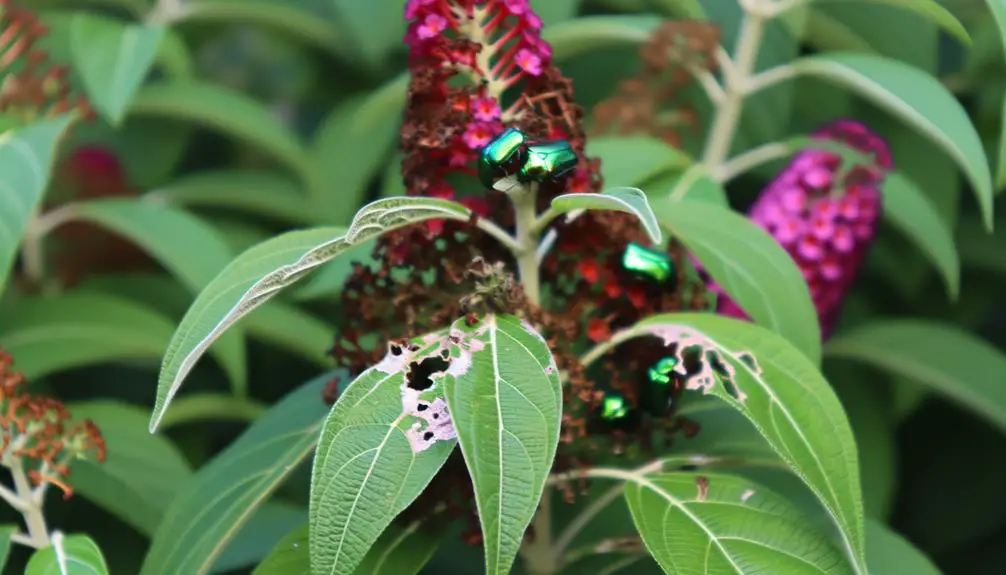
Known for their voracious appetite, Japanese beetles (Popillia japonica) pose a significant threat to butterfly bushes (Buddleja spp.), often causing extensive foliage damage. These beetles feed on the leaves, chewing out the tissue between veins, resulting in a characteristic skeletonized appearance.
Adults are most active during the summer months, and their feeding can severely reduce the photosynthetic capacity of the plant, leading to diminished vigor and aesthetic value.
Key concerns include:
- Rapid defoliation: Quick and extensive leaf loss can severely weaken plants.
- Reduced flowering: Essential for butterfly attraction, diminished blooms impact garden biodiversity.
- Secondary infections: Open wounds from feeding attract pathogens.
Understanding these threats is imperative for effective pest management.
Root Borers
Unlike the conspicuous damage caused by Japanese beetles, root borers inflict harm in a more insidious manner, targeting the root system of butterfly bushes and compromising the plant's overall health and stability.
These pests, typically the larvae of moths or beetles, burrow into the root cortex, disrupting nutrient and water uptake. Signs of infestation include wilting, stunted growth, and eventual plant death, often misattributed to other stressors.
Root borers can be identified by examining the roots for tunneling and frass deposits. Effective management involves soil drenching with appropriate insecticides and maintaining ideal plant health to resist infestation.
Regular monitoring and early intervention are essential to mitigate the destructive impact of root borers on butterfly bushes.
Thrips
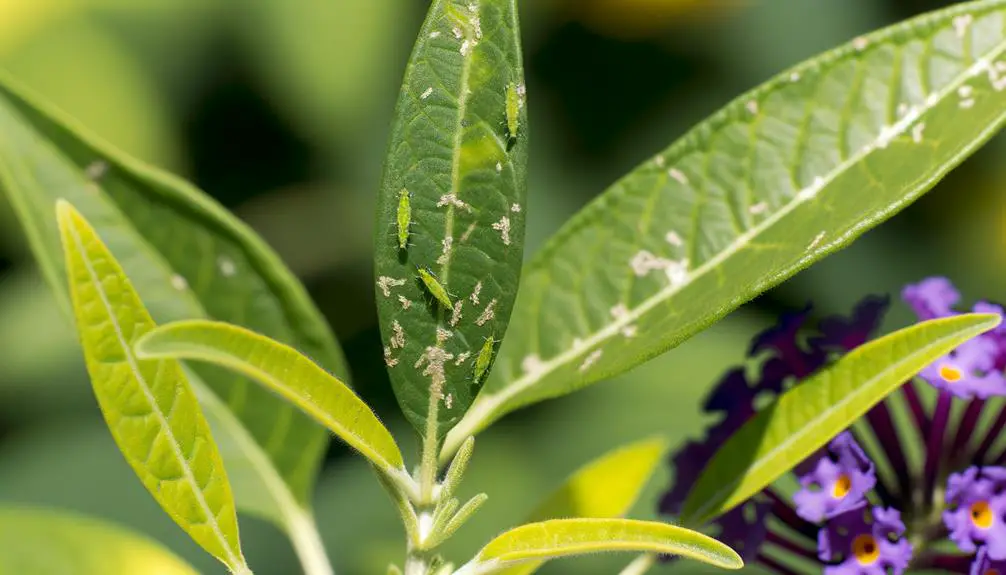
Thrips, minuscule insects that feed on the cellular contents of butterfly bush foliage, can cause significant damage through their rasping-sucking mouthparts. Their feeding results in silvery, scarred leaves, which hinders photosynthesis and overall plant health.
These insects are typically less than 1/20th of an inch long and can be challenging to detect without magnification. Infestations can lead to discolored, stippled leaves, which diminish the aesthetic appeal of the butterfly bush.
Additionally, reduced flowering occurs as thrips compromise the plant's reproductive potential. Distorted growth may also be evident, with new shoots appearing twisted or malformed. Furthermore, increased vulnerability to disease arises, as damaged tissue offers entry points for pathogens.
Effective management requires regular monitoring and potentially biological controls, such as predatory mites.
Slugs and Snails
Slugs and snails, nocturnal mollusks with rasping mouthparts, can severely damage butterfly bush foliage by creating irregular holes and feeding trails.
These gastropods utilize their radula, a specialized structure lined with tiny teeth, to scrape and consume plant tissue.
Butterfly bushes (Buddleja spp.) are particularly vulnerable to their nocturnal feeding habits, which often go unnoticed until significant damage has occurred.
The presence of silvery mucous trails on leaves and surrounding soil is a diagnostic indicator of their activity.
Environmental conditions such as high humidity and dense vegetation create an ideal habitat for these pests, exacerbating the problem.
Effective identification of these feeding patterns is essential for understanding the extent of the infestation and planning subsequent management strategies.
Preventive Measures
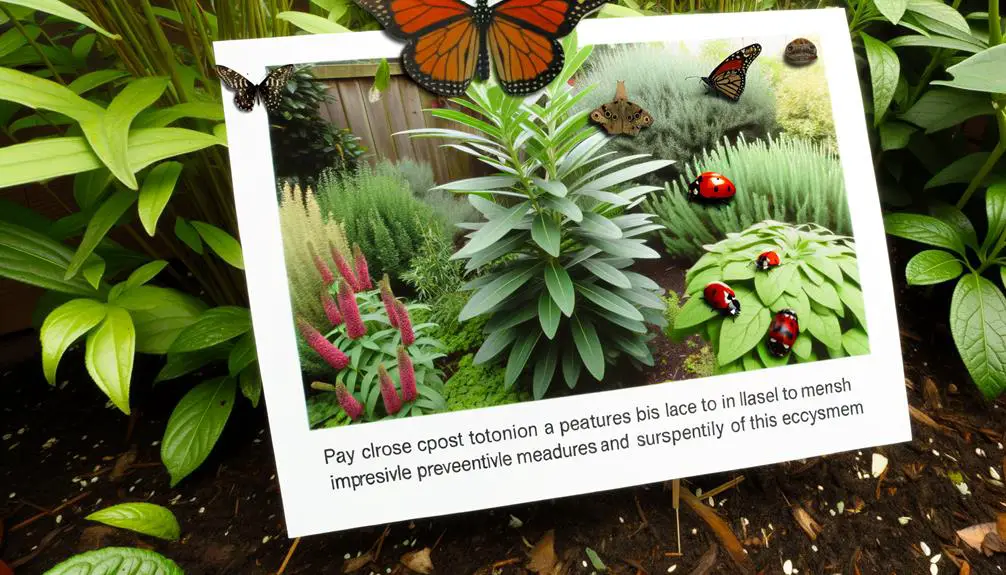
Implementing preventive measures is essential for protecting butterfly bushes from potential damage caused by slugs, snails, and other pests.
Effective strategies include maintaining a clean garden environment, as decaying plant matter attracts these pests. Regularly inspect the foliage and stems for early signs of infestation. Introducing natural predators, such as birds and beneficial insects, can help control pest populations. Applying barriers like copper tape around the base of the plants can deter slugs and snails.
- Vigilant Monitoring: Early detection of pests minimizes extensive damage.
- Natural Predators: Encourage birds and beneficial insects to inhabit your garden.
- Sanitation Practices: Remove decaying plant material to reduce pest habitats.
These methods, when implemented consistently, can greatly protect your butterfly bush.
Conclusion
The confluence of diverse insect species such as aphids, spider mites, caterpillars, leaf miners, scale insects, root borers, thrips, slugs, and snails presents a significant threat to Buddleja spp. (butterfly bush).
Each pest's specific feeding behavior disrupts the plant's physiological processes, ultimately compromising its growth and ornamental value.
Implementing preventive measures, including integrated pest management, can mitigate these impacts, ensuring the health and longevity of butterfly bushes in horticultural settings.


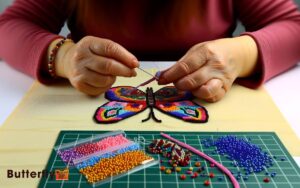


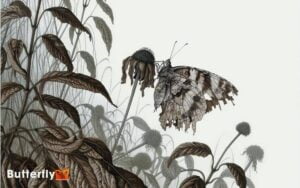

mc1d5m
vbl2y3
Known for being a watery substitute for oral testosterone steroids,
its results are similar to those of Take A
Look At but slightly different. Now that you know that even the
best oral anabolic steroids will come with their fair share of steroids,
let’s have a glance at the most secure choices.
Stacking Deca Durabolin with an androgenic steroid similar to Anadrol, testosterone, or
trenbolone can mitigate low NO ranges. Our checks indicate that
blood pressure will improve at a rate that’s comparable to Anavar
somewhat than harsher anabolic compounds. Trenbolone has a stimulating effect on the central nervous system, triggering thermogenesis and aiding fats burning.
However, such stimulation can contribute to adverse
results, including insomnia, anxiety, restlessness, elevated sweating, and even paranoia in delicate customers.
However, it is equally effective by way of its ability to build muscle tissue.
A Testosterone Cypionate only cycle is one of the best place to
begin for a newbie. It allows you to evaluate your response exclusive to this
steroid before you contemplate stacking it with any others.
This places you above commonplace testosterone replacement, however
not an extreme dose that causes more outstanding side effects.
The oral version is actually 17 Beta Alkylated, that
means it is less liver-toxic than the 17 Alpha Alkylated.
Anavar is usually referred to as the feminine steroid but is used by males
all the same. It can also be the steroid with the least quantity of unwanted effects, barring
possibly solely Primobolan. Stanozolol, Winstrol, or Winni is likely certainly one of the hottest chopping medication in the marketplace.
Clearly, the 17 alpha Alkylation signifies that you
now have an orally out there drug, whilst the double bond on the C1 and C2 will end in less androgenicity.
Many males declare their disappointment that Masteron is such
an incredible steroid in each different means besides its capability to take away your hair actually.
“Confident, assertive, happy” is what Masteron can do to our
mental outlook. So many of us will find it one of the most important advantages of this
steroid, even beyond its bodily effects. Drostanolone propionate has a half-life
of about two days, whereas Drostanolone enanthate has a half-life of about ten days.
Bodybuilders who inject Winstrol solely want to do so once,
every other day. When you are taking Winstrol by mouth, the dose is lower than if
you are taking it by way of injection. The same steroid is sold under many different
names as well, including Menabol and Stanol,
but Winstrol is the preferred model of Stanozolol within the USA.
These problems embrace liver injury, hypertension, and coronary heart illness.
Your hormones can even get out of balance, with low testosterone or excessive estrogen being frequent.
To scale back these risks, all the time use steroids carefully and ask a healthcare skilled for advice on correct use and dosage.
Bodybuilders start the cutting section before participating in competitions.
Ripped means a physique fat share, which could be very low as 2 percent.
Although, pure bodybuilders can achieve lean physic in 5 to 6 % of body fats.
Reaching a degree of 2 % is very powerful, but you can make
it simpler by taking steroids.
One of one of the best things about using Anavar for slicing is the lack of aromatizing activity.
This makes bloating unlikely and helps hold the
muscular tissues onerous and well-defined. You must be conscious that gas and bloating are common unwanted effects with Dianabol.
At age 62, “Big Bill” shares his knowledge to dominate one of many
ultimate power marks. The solely difference between them
will be the frequency you must administer. In this article, we will break down these cycles, explaining their key variations and when they’re best suited in your goals.
We assessed the value of each legal steroid to make sure it provides worth for
money.
For these unaware, every week we’ve a specific steroid or PED up for discussion.
The objective of those threads is to generate discussion in regards to the posted
compound and get all kinds of user experiences and suggestions about it.
This is all anecdotal, of course, and you need to take these evaluations with a
grain of salt. Best for girls and novices, leading to muscle acquire with fewer unwanted effects.
Low anabolic exercise with few side effects, excellent for people in search of
protected and efficient features. Whether your hair will develop again after being lost whereas utilizing Testosterone Cypionate relies upon mostly
on genes, how extensive the hair loss is, and whether the follicles can regrow
hair. Many men will find male sample baldness irreversible without some
type of hair restoration remedy.
For this cause, tapering off your dose rather than a sudden cease might help
mitigate these effects. Whereas this isn’t a type of PCT,
it is a strategy to scale back post-cycle unwanted effects – mainly
in case you have used SARMs at greater doses. Combining two of one of the best fat loss or chopping
SARMs in a stack will supercharge your fat-burning results.
Cardarine, technically a PPAR receptor agonist,
is usually stacked with SR9009, a PPAR alpha modifier, for supercharged
outcomes. To perceive the potential benefits that SARMs can have
for girls, it’s crucial to have a basic understanding of what
an SARM is and why it’s completely different from an anabolic
steroid. It’s essential to understand that all SARMs are classed as investigational drugs only,
with none but being permitted for any use.
You can discover some suppliers promoting the above for underneath $100 on the cheaper finish.
While I all the time say that worth is not an indication of quality, you do run the risk of getting bunk
Masteron if you go for absolutely the least expensive sources.
Utilizing Masteron, even for private usage in the Usa, is prohibited.
It’s a harmless however dreaded aspect effect, one of the first issues males
will contemplate before utilizing Masteron. As a DHT-derived
steroid, you can count on hair loss to be a problem with Masteron, and it may be a reasonably severe fee of
hair loss.
Andarine comes with the flexibility to enhance bone
density as well and is taken into account one of the milder SARMs total.
Green tea has only a small quantity of Caffeine, but it’s been shown in numerous
studies to assist facilitate weight reduction when paired
with a balanced calorie-deficient food regimen and train plan. However, phentermine is still
FDA-approved and some physicians do continue to prescribe it to sufferers
who are overweight and who must lose weight to enhance their health.
You ought to never use phentermine alongside stimulant weight-loss medication like
clenbuterol, albuterol, or ephedrine as this could exacerbate the
chance of dangerous side effects.
References:
JBH News
Oh my goodness! an amazing article dude. Thank you Nonetheless I am experiencing problem with ur rss . Don’t know why Unable to subscribe to it. Is there anybody getting equivalent rss drawback? Anyone who is aware of kindly respond. Thnkx
https://www.zoritolerimol.com